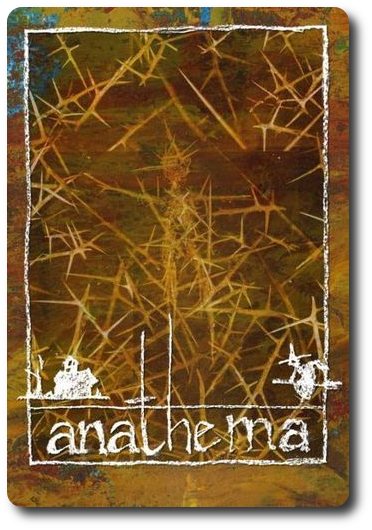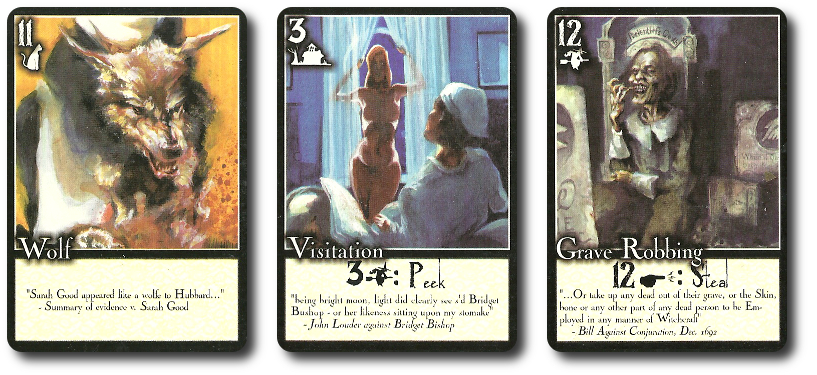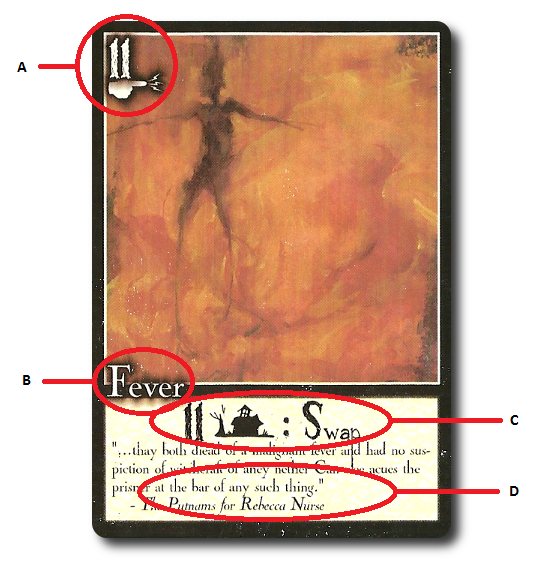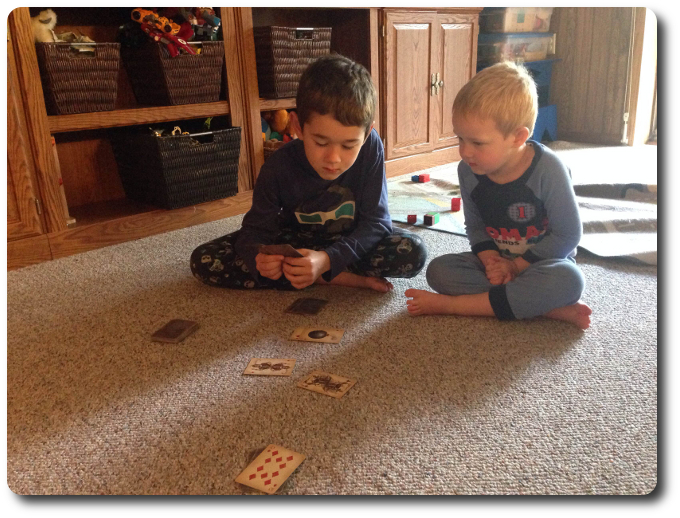
The Basics:
- For ages 8 and up
- For 2 to 4 players
- Approximately 30 minutes to complete
Geek Skills:
- Active Listening & Communication
- Counting & Math
- Logical & Critical Decision Making
- Strategy & Tactics
- Risk vs. Reward
- Cooperative & Team Play
- Hand/Resource Management
Learning Curve:
- Child – Presumed Easy
- Adult – Easy
Theme & Narrative:
- None
Endorsements:
- Gamer Geek mixed
- Parent Geek mixed
- Child Geek untested!
Overview
Salem was built upon the bedrock of religious doctrine that was riddled with cracks of intolerance, superstition, and ignorance. When fear and panic swept through the community in the 1600’s, mass hysteria debased unjustly accused individuals to a level parallel to demons and witches. What some called purification is now known to be murder. A formal curse by a religious leader is called an “anathema”. If we let our fears rule us, we are truly cursed creatures who are forever lost in shadow.
Anathema, designed by Kevin Brusky, Ray Mulford, and published by APE Games, is comprised of 52 cards (13 cards each in 4 different suits). The cards are thick and durable. Not included with the game, but necessary to play, is a pen or pencil and piece of paper to keep track of the players’ scores.
The artwork on the cards is outstanding, but some Child Geeks will find them disturbing. In fact, some of our Parent Geeks found them disturbing. The game itself has no real narrative to speak of, but the game’s theme is based on the Salem Witch Trials held in the early 1690’s of what was then Colonial America. Which is to say, mass hysteria, light debauchery, witchcraft, evil omens, sickness, and disease are all portrayed in the card illustrations. Here are a few that were identified by our Parent Geeks as “not appropriate” for their Child Geeks. I’ll leave it up to you to decide what is best for your audience. Unfortunately, the cards that made some of the Parent Geeks uncomfortable could not be removed from the game without negatively impacting the overall game play.

Game Set Up
Note: Anathema has two types of play: a basic and an advanced game. Regardless of which game type is played, game set up is the same.
To set up Anathema, first take the deck of cards and shuffle them. The player shuffling the cards is referred to as the “dealer”.
Second, the dealer gives 2 cards, face-down, to every opponent. Players should look at their cards but keep them hidden from their opponents at all times.
Third, the dealer places 2 cards, face-up, to the center of the playing area.
Fourth, the dealer gives 2 cards, face-down, to themselves.
Fifth, the above is repeated until all players have 4 cards in their hand and there are 4 cards, face-up, in the center of the playing area.
That’s it for game set up. The player to the dealer’s left goes first.
Card Anatomy
The cards in Anathema could have up to 2 pieces of information relevant to the player. They are summarized here.

A: Each card has a number values (1 through 13) and a suit (Spell, Witch, Village, and Familiar). The number value and suit on the cards is used in both the basic and advanced game.
B: The name of the card, which is purely thematic and is not used to determine any outcome in the game.
C: If the card has any special abilities, they are listed here. The card number and suit shown identifies a specific card. If the specific card shown is captured using the card that lists the special ability, the player can choose to trigger the special ability or not. The special abilities are described in “The Advanced Game” section below. A card’s special ability is not used in the basic game.
D: The card’s flavor text that further reinforces the game’s theme, but nothing else.
Note that not all cards list flavor text or special abilities. Some cards do not have any special abilities or flavor text. In their place is a single number (a “1” or a “2”). These number values are used when scoring a round.
The Basic Game
The basic game of Anathema is played in the same was as the traditional card game, Casino. In fact, it is Casino. On the upside, if you learn how to play Anathema, you are learning how to play 2 games at once! Or, if you are really lucky, you already know how to play Casino and can jump right into Anathema without issue. For everyone else, here’s how you play the game.
Anathema is played in rounds with no set number of rounds per game. A single round is comprised of several turns. On a player’s turn, they will complete 1 of 3 possible actions by playing 1 card from their hand. Once the player completes their turn, the next player in turn order sequence goes.
Capture
To capture a card, the player must be able to combine several cards or just one so the total number value of the cards grouped together from those found in the center of the playing area is equal to a single card number value found in the player’s hand. For example, if the player had a “7” in their hand, they could combine a “5” and a “2” together from the center of the playing area. If the player can capture a card or cards, they place a card from their hand face-up in front of them, announce they are capturing, and then show their opponents which cards they are targeting. Note that a player can capture multiple cards at once. For example, if the visible cards in the center of the playing area showed a “10”, “5”, and “5”, the player could capture all three by playing a “10” from their own hand. All captured cards, including the card from the player’s hand that is used to capture them, are collected and placed face-down in a pile in front of the player referred to as the player’s “Scoring” pile.
If a player captures all the cards from the center of the playing area (be it 4 or less), this is considered a “sweep”. The cards are still captured as normal, but one of the cards captured is placed face-up when they are placed in the player’s Scoring pile. This face-up card will be used to quickly identify how many sweeps the player has completed during the round.
Build
Building allows a player to combine a card from their hand with one or more cards from the center of the playing area. The cards are forever attached together and the build’s value is the sum of all the card number values included in the build. For example, if a “5” was built with a “2” and “6”, the total number value would now be a “13” for the build. When the player creates a build, they arrange the cards in the center of the building area accordingly and then play their card to it, announcing the number they are building to. The catch is that the player MUST be able to capture the build on their next turn using a single card. This means the player MUST have the card in their hand they can use to capture all the cards in the build prior to creating the build. However, an opponent could capture the build if they had the right card. As such, there is risk in creating a build.
Players can always add cards to existing builds, but cannot remove cards from a build.
Trail
Trailing a card allows a player to play one card from their hand and place it, face-up, to the center of the playing area. Cards played in this way cannot be placed on a build, but can be attached to a build by the player’s opponent or by the player on their next turn
The Advanced Game
The advanced game is played just like the basic game, except for the following exception.
Special Card Abilities
Listed on some cards is a special ability that is triggered when the card is used to capture another card that has a specific number value and suit. These are referred to as “capture rewards”. The special abilities can be triggered by the player if they want. If they do, it must be completed before the turn is over and cannot be saved for later. The special abilities are summarized here.
- Peek: The player can look at all the cards in an opponent’s hand. The information the player gains cannot be verbally shared at the table with any other player. Useful ability when playing the game variant that allows for team play with a partner.
- Swap: The player can take 1 face-up card from the center of the playing area and put it in their hand. They then replace it with a different card from their hand, placing it in the center of the playing area.
- Steal: The player can take 1 card at random from an opponent’s Scoring pile and add it to their Scoring pile. The stolen card must be face-down in the Scoring pile. Any face-up cards that count sweeps cannot be stolen.
Continuing and Ending a Round
When the game is first set up, 4 cards are dealt to each player and 4 are dealt to the center of the playing area, face-up. An additional 4 cards will be dealt to each player when none of the players have any cards left in their hand. When the dealer can no longer deal 4 cards to each player, they call “Last Deal”. Game play continues until the last of the cards are played. The round is now over. The last player to capture cards collects any remaining cards left in the center of the playing area. This is not considered a sweep and the collected cards are placed face-down in the player’s Scoring pile. The players now count their points.
A player’s total score for the round is determined by completing 4 simple steps.
- All players count the total number of cards in their Scoring pile. The player with the most cards earns 3 points.
- All players count the total number of cards with the “Familiar” suit in their Scoring pile. The player with the most “Familiar” suit cards earns 1 point.
- Every player earns 1 point for every sweep (count the face-up cards in the Scoring pile).
- Players add 1 or 2 points for every card they have in their Scoring pile that lists a “1” or a “2” in the card area where the card’s special ability and flavor text would normally be.
After the total points earned for the round are determined, they are recorded and a new round now begins. Use the game set up instructions to start a new round of play. The player left of the last dealer is the new dealer.
Ending the Game
The game continues as described above with scoring ending every round until 1 player earns 21 or more points. This player is the winner of the game.
Game Variants
Anathema comes with two game variants that can be used with either the basic or advanced game. They are summarized here.
Multiple Builds
A player can only build once per turn, placing 1 card from their hand to the center of the playing area. The build value is the combined total of the number values listed on the cards. Multiple build values are a bit different. Where a normal build value is the sum of all the cards it contains, a multiple build can be captured using a single card that is less than the sum of the cards. All a player needs to do is organize the cards in the multiple build so that their sums equal the card played.
When playing to a multiple build, the player places a card as normal and groups the cards together. Instead of stating the build’s value, they call it a “multiple build value” and then give the number value that can be used to capture it. The player must be able to capture the multiple build on their next turn. A multiple build is captured by using a single card from the player’s hand. From the multiple build, the player must be able to use single and combined cards that have a sum total equal to the number value of the card placed.
For example, a multiple build of “5” that contains card values “5”, “4”, “1”,”2″, and “3”, can only be captured by a “5” card value. It would look like this:
- “5” = “5”
- “5” = “4” + “1”
- “5” = “2” + “3”
Partner Play
If playing with 4 players, create teams comprised of 2 players each. Have each team member sit opposite of each and ensure that the turn order sequence going around the table always allows a player from the opposite team to have a turn right after the other team goes. Game play does not change, but partners add their earned points at the end of the round together. Use the “Peek” card ability with your partner to quickly learn what cards they have and set them up for big points!
To learn more about Anathema, visit the game’s web page.
Prediction
Anathema is a themed version Casino, which is not a hard game to teach or to learn. The game’s illustrations, however, are going to cause some of our Parent Geeks to squirm. When I showed the game to my wife, she was not at all pleased with some of the cards. That does not bode well for the game.
I don’t think I’m going to have any problem getting Anathema in front of my Parent and Gamer Geeks, but the Child Geeks might not see Anathema until they get a bit older. I’ll leave it up to the Parent Geeks to decide what is best for their children and respect their wishes. When the game is played, I don’t see any reason why the Parent Geeks will not approve it unless the game is found to be inappropriate for their children. They might approve it when they just play it with their peers, however. For the Gamer Geeks, I think the approval rating will be mixed at best. Some of the Gamer Geeks enjoy more traditional card games, but not enough to suggest a majority vote for approval.
Let’s play Anathema and see if the game does well or is cursed to fail.
Final Word
Unfortunately, we were unable to find any Parent Geeks who were willing to put Anathema in front of their children. This includes my wife, who as far as I’m concerned, has the final say when it comes to what games should or should not be placed in front of our little geeks. While the images are not overly violent, there is one in particular that screams of sexuality. Oddly enough, scary images are often times OK, but any images that suggest sex are more times than not vetoed (Nitro Dice, for example). That being said, I didn’t want to leave the Child Geeks out. Instead, I played Casino with the Child Geeks using a standard deck of cards. I am pleased to report that all the Child Geeks we taught the game to had no problem understanding the rules and playing the game. Obviously, we were unable to use the special abilities listed on the Anathema cards, but we did use the multiple build and partner play game variants. Both were found to be fun and useful. After playing several games, I asked the Child Geeks what they thought of Casino. All the Child Geeks voted to approve the game. This should not suggest that Anathema is also Child Geek approved. It does serve to demonstrate that both Casino and (by way of association) Anathema could be played by Child Geeks as young as 8-years-old. Since we did not actually play Anathema with the Child Geeks, it remains untested and presumed.

My oldest little geek contemplates his next move while his younger brother looks on
Anathema received mixed approval from the Parent Geeks. While all the Parent Geeks, including the non-gamers and traditional card game players, had no problem playing the game using both the basic and advanced rules, a majority of the Parent Geeks just couldn’t agree to endorse a card game they didn’t want their Child Geeks to play. According to one Parent Geek, “This entire game seems unnecessary. If I want to play Casino with my kids, I wouldn’t put this deck of card in front of them.” Not all the Parent Geeks felt this way. According to one of the Parent Geeks who approved the game for their peer group, “I like the advanced game play and the special card abilities. It adds a neat little twist to an otherwise so-so game. I’d play this again, but my kids need to be older before I play it with them.” In the end, the Parent Geeks all agreed that Anathema did a good job, but some questioned its value overall.
The Gamer Geeks were also mixed, but not because of the game’s theme. Gamer Geeks will play games with some of the most disturbing themes and narratives available without a second thought. This includes games like Cards Against Humanity that isn’t considered appropriate by humankind. The elitist were split regarding the game’s overall worth at their gaming table. Some of the Gamer Geeks are fond of traditional card games and found Anathema a welcomed diversion that was perfect for game fillers or when a lighter game was being asked for that had a bit of theme. For this group, the advanced play was well received and the game was enjoyed. According to one of these Gamer Geeks, “This is a solid card game rethemed into something that most Gamer Geeks can relate to. That makes it easier to get to the table and easier to enjoy. I liked it and would play it again.” The other group didn’t see much value in the game whatsoever, despite it having a theme they could get behind. For these Gamer Geeks, they found the game to be too light and not at all interesting. According to one of these Gamer Geeks, “This is a game I played as a kid. I found it silly then and I find it silly now. There are so many more interesting games I would play before this one, I can’t even begin to suggest to you how little I am interested in playing this card game right now.” In the end, the more traditional and casual Gamer Geeks enjoyed Anathema while the more hardcore Gamer Geeks clearly did not.
I learned how to play Casino as a kid from my grandmother. She was the only one I played the card game with until she passed away. I didn’t play Casino again until I was overseas participating in a military exercise in Germany. Long nights were spent playing the game with my fellow soldiers as we exchanged stories of home. When I did return home, Casino wasn’t a game I wanted to play anymore. Now, with Anathema, the card game my grandmother taught me all those years ago is once again back in my life and I find myself teaching it to my children. I’m pretty sure my grandmother would approve.
Overall, I’m not displeased with Anathema, but I do find it to be unimaginative. Anathema is nothing more than Casino with a thematic element pasted on top of it. That’s not enough for me to get excited about the game. The special card abilities don’t really add much value, in my opinion. In fact, I’d suggest they feel somewhat clunky and out-of-place. As such, I enjoyed the basic game much more than the advanced game.
Whether or not Anathema is right for you is going to depend on the answer to the following question: Do you want to play a themed version of Casino? If the answer is yes, seek out a copy of Anathema as soon as possible; I doubt you’ll be disappointed. If the answer is no. then you are going to be just fine playing Casino with a standard deck of cards.
This game was given to Father Geek as a review copy. Father Geek was not paid, bribed, wined, dined, or threatened in vain hopes of influencing this review. Such is the statuesque and legendary integrity of Father Geek.




Pingback: Big Top Game Review - Father Geek